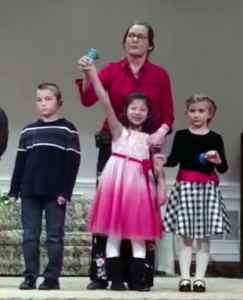
Princess Sunshine
KNOWN IN REAL LIFE AS:
HOPE PALMER
SUPERPOWER:
SMILING
DIAGNOSIS:
CEREBRAL PALSY

Meet Princess Sunshine (Hope Palmer) at the Akron Marathon on September 28.
Meet Princess Sunshine
Hope Palmer, Age 9, from Mogadore, Ohio
Why Hope is an #ACHero: At 7, Hope came to America to live with a new family unable to speak the language or walk because of her health condition. With strength and a smile, Hope has put in countless hours of therapy to become sure-footed and more self sufficient while also learning to speak and read a new language.

Sidekicks: Her sisters – Nikki, Jessie, Gloria, Hannah – her dad, her Akron Children’s therapists, Laura and Renee, her surgeon, Dr. William Schrader, cousin Tianna, Aunt Jen and Aunt Tracy.
When she’s not busy overcoming obstacles: Hope’s biggest joy is singing and dancing with her sisters. With a vivid imagination, Hope also loves to play and draw.
Did you know fact: Hope and all of her sisters were adopted from China.

Hope’s Story: They say love is the universal language understood by all and, thankfully, Hope, her family and her care team are fluent.
With no proper education or medical records, Hope was adopted from China at age 7. She had an instant family, but was unable to talk with them about her past or her health.

“When Hope came home 2 years ago, she was physically very weak, her hand was clinched up tight in a ball and she couldn’t lift her foot high enough to take a step,” said Tammy Palmer, Hope’s mom. “We didn’t know anything about her medical history, so the first place we took her was to Akron Children’s for evaluation.”
At Children’s, Hope had her first well check and was referred to orthopedics and neurology for a closer examination.
Hope was diagnosed with hemiplegia, which caused partially paralysis on the left side of her body, and cerebral palsy, which affected her overall muscle tone, movement and motor skills. She also had severe damage to the right side of her brain, which impacted her memory and speech.

Hope’s physiatrist, Dr. Kathryn Mosher, created a care plan for her and would become the central source for Hope’s medical care. Hope immediately started physical and occupational therapy once a week, 4-hours-a-day, to build strength and flexibility in her legs, arms, shoulders, elbows and fingers.
Hope had a lot of ground to cover. She couldn’t walk, feed herself or even comb her hair. Hope took on challenges at therapy with a smile, and her dad watched so they could practice at home to help keep her muscles stretched out.

“The thing that impresses us most about Children’s is the compassion of everyone we’ve ever come in contact with,” said Tammy. “You can tell they all care about Hope; it’s not just a paycheck to them. It’s an investment in kids…in Hope.”
While occupational therapy was focusing on her fine motor skills, Hope was also working on large muscle movements in physical therapy to aid in walking. The tendons in Hope’s legs and ankles were so tight she couldn’t put her foot down to walk. It was a challenge, and her physician realized therapy wasn’t enough.

Dr. William Schrader operated on Hope to extend her left Achilles tendon to help with leg alignment. Afterward, for the first time, Hope was able to wear a shoe without it falling off. With surgery and daily therapy, Hope’s walking began to greatly improve. Today, her care team tries to give her more independence through stretching and bracing to improve her overall mobility.
Beyond her physical challenges, language has also been a hurdle.

“Early on we had an interpreter, but Hope knew so few words in Chinese it wasn’t really making a difference,” said Tammy. “Learning is a challenge for Hope, but we find ways and she is excelling.”
As Hope grows, her family continues to work with Children’s for her ongoing medical needs – from orthopedic shoes to education plans.

“We have a great medical team that’s always thinking of new treatment options for Hope and setting new goals for her, which we really appreciate,” added Tammy.
Hope continues to improve her physical and cognitive skills with daily therapeutic play and home schooling. She also sees Drs. Schrader and Mosher a few times a year to check on her progress and continues with physical and occupational therapy to ensure her muscles stay flexible.
“Hope, and all of our daughters, have taught us there are no limitations to what they can do,” said Tammy. “Whatever Hope does, she does it with a smile on her face and joy in her heart.”





